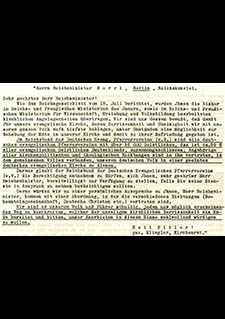The Reich Ministry of Church Affairs
In July of 1935, Hitler put Hanns Kerrl, minister without portfolio, in charge of dealing with church affairs. The establishment of the “Reich Ministry of Church Affairs” deprived the German Christian church government under Reich Bishop Ludwig Müller of its power. At the same time, it became clear that the Confessing Church would not obtain state recognition. Hanns Kerrl believed in the reconcilability of National Socialism and Christianity. His goal was a unified Protestant Reich Church controlled by the state, which was intended to include all of German Protestantism’s factions.
Many pastors and church leaders viewed Kerrl’s assignment as an offer from the state to reorganize the Protestant church, which was in disarray, which ought not to be refused. In a letter of July of 1935, the National League of German Protestant Clergy Associations, the Protestant pastors’ association, declared itself only too willing to make itself available for potential work together. Kerrl was even able to earn the trust of other circles of the Confessing Church at first. Against the opposition of the Councils of Brethren, the intact regional churches affiliated with the moderate Confessing Church advocated supporting Kerrl.
The “Law for the Consolidation of the German Evangelical Church” of September 24, 1935 vested the minister with extensive powers to intervene in the church. He used his powers to “bring peace” to the Protestant church in keeping with his ideas and established so-called church committees to do so. When these committees failed in 1937, he began to neutralize the intact regional churches by way of decree, while criminalizing the Councils of Brethren and having them pursued by the Gestapo. At this point, even the intact regional churches concluded that the Reich Ministry of Church Affairs was a ministry of the church’s ruination, as Thomas Breit, member of the Bavarian High Consistory, formulated it in April of 1937.
Kerrl’s increasingly diminishing capability to dictate the principles of the state’s policy toward the church himself also did not go unnoticed in church circles. He actually had a weak position in the Nazi power structure from the outset. Many powers were concentrated in other ministries, above all among anti-church prominent party members such as Alfred Rosenberg, Heinrich Himmler, Rudolf Hess and Martin Bormann. When the church committees failed, Kerrl lost Hitler’s support and was no longer able to assert his authority over his rivals within the party. Elements of the church center nonetheless held fast to their conviction that the Protestant church could be reorganized in trusting cooperation with the Nazi minister.
Source / title
- ©Evangelische Arbeitsgemeinschaft für Kirchliche Zeitgeschichte München, A 1. 50.

